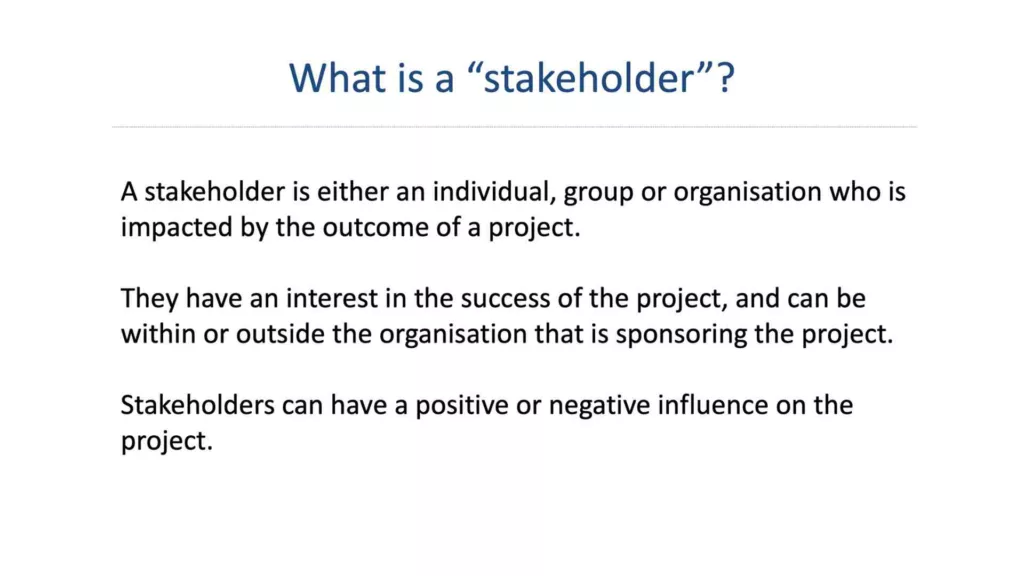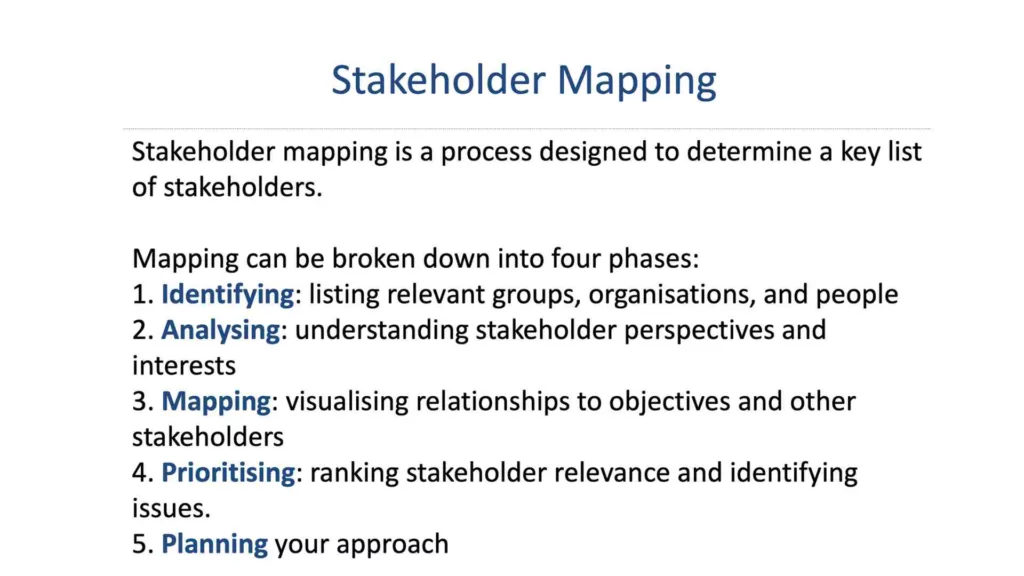Posted in Blog, Innovation by Jo North
Stakeholder Engagement for Innovation Success
Stakeholder engagement has emerged as a crucial element for achieving business success in today’s fast-paced and ever-changing business landscape, especially for innovation. Gone are the days when companies could focus solely on satisfying customers and maximizing profits. Now, businesses need to actively involve all relevant stakeholders, including employees, customers, suppliers, and the community, in order to thrive in a highly competitive marketplace.
From enhancing brand reputation and fostering innovation to mitigating risks and ensuring sustainable growth, stakeholder engagement plays a pivotal role in shaping a company’s innovation strategy and performance. By actively listening to and addressing the needs and concerns of stakeholders, you can build stronger relationships, strengthen trust, and create a positive impact on society.
In this article, we will explore why stakeholder engagement is vital for innovation success and the key strategies that you can implement in your business to effectively engage with your stakeholders.
Get ready to unlock the power of stakeholder engagement and take your business innovation to new heights.

The Importance of Stakeholder Engagement to Innovation
Stakeholder engagement refers to the process of involving individuals or groups who have a vested interest or influence in an organization’s activities. These stakeholders can include employees, customers, investors, suppliers, regulators, and the local community. Engaging with stakeholders goes beyond simply communicating with them; it involves actively seeking their input, involving them in decision-making processes, and addressing their concerns and expectations.
A well-defined stakeholder engagement plan is not merely a nice-to-have, but a best practice fundamental to sustainable development goals and corporate governance. The level of engagement with different people, from project team members to local communities and indigenous groups, has a significant potential impact on the success of a proposed innovation project.
Successful stakeholder engagement is vital for innovation success for several reasons. First and foremost, it enhances your company’s brand reputation. When stakeholders feel heard and valued, they become advocates for the company, spreading positive word-of-mouth and attracting new customers. Moreover, engaged stakeholders are more likely to remain loyal to the brand, leading to increased customer retention rates.
Engaging Stakeholders
Stakeholder engagement also helps your business to innovate better. By involving stakeholders in brainstorming sessions, knowledge exchange activities, innovation sprints and design thinking workshops and seeking their feedback, you and your team will gain valuable insights and perspectives to drive product and service improvements. Engaging with stakeholders also helps you stay ahead of emerging trends, and adapt to changing market demands.
Identifying Stakeholders and Their Interests
Before your business can effectively engage with its stakeholders, you first need to identify and understand who your stakeholders are, and what their interests and concerns may be. Stakeholders can be categorized into internal and external stakeholders.
Internal stakeholders include employees, board members, and shareholders. They have a direct interest in the success of the organization and are directly affected by its decisions and actions. Understanding their needs and concerns is essential for creating a positive and productive work environment.
External stakeholders, on the other hand, can include your entire innovation ecosystem – your customers, suppliers, investors, regulators, and the local community. These stakeholders may have different expectations and concerns, and it is important to identify and address them accordingly.
Inclusive public participation is one of the key concepts in stakeholder management. This includes consultation with key stakeholders, such as civil society organizations, business leaders, groups campaigning for the environment, wildlife habitats and so on, which all represent different stakeholder groups with varying levels of interest and influence. Stakeholder mapping is an essential first step to identify critical stakeholders and determine who has the greatest levels of influence and interest in what you’re doing.
To identify stakeholders and their interests, you can conduct surveys, interviews, and focus groups. You can also analyze social media conversations and online reviews to gain insights into what stakeholders are saying about your company and its products or services. Once stakeholders are identified, you can their prioritize your engagement activities, based on the level of influence and importance of each stakeholder group.

Benefits of Effective Stakeholder Engagement
Effective stakeholder engagement offers numerous benefits for innovation. Firstly, it helps in building trust and credibility. When stakeholders feel that their opinions and concerns are valued, they are more likely to trust the company and its intentions. This trust translates into stronger relationships, which can lead to increased customer loyalty and advocacy.
Secondly, stakeholder engagement can help you to identify and manage your innovation risks more effectively. By involving stakeholders in risk assessments and mitigation strategies, your organization is able to gain a broader perspective on potential risks and develop more robust risk management plans. Engaging with stakeholders also enables your innovation team to address issues and concerns proactively, preventing them from escalating into larger problems.
Thirdly, stakeholder engagement fosters transparency and accountability. When you actively involve stakeholders in innovation decision-making processes, you are more likely to develop innovations that are accessible, fair and sustainable. This transparency builds credibility and demonstrates a commitment to ethical practices, ultimately enhancing your company’s reputation.
Strategies for Engaging Stakeholders in Your Innovation Projects
Create and implement a comprehensive stakeholder engagement strategy for each of your innovation projects. Here are some key strategies to consider:
1. Communication: Open and transparent communication is the foundation of stakeholder engagement. Use various communication channels, such as email newsletters, social media platforms, and regular meetings, to keep stakeholders informed about innovation updates, initiatives, and progress.
2. Participation: Actively involving stakeholders in innovation decision-making processes can make them feel valued and empowered. Organize focus groups, workshops, and advisory committees to provide stakeholders with opportunities to contribute their insights and ideas.
3. Collaboration: Collaborating with stakeholders on innovation projects and initiatives creates a sense of ownership and shared responsibility. Achieve this through building a thriving innovation ecosystem, and through partnerships, joint ventures, or co-creation of products and services.
4. Feedback mechanisms: Implementing feedback mechanisms, such as surveys, suggestion boxes, and online forums, allows stakeholders to provide their opinions and concerns about your innovations easily. Regularly reviewing and acting upon this feedback demonstrates a commitment to continuous improvement.
5. Social responsibility: Incorporating social responsibility into your innovation practices helps to engage stakeholders who are passionate about environmental or social issues. Use initiatives such as corporate social responsibility programs, sustainability efforts, or community outreach programs.
Stakeholder Engagement Activities
Effective meetings with smaller groups or major groups can also aid in mitigating technical risks. Group sessions should be a high level of engagement, where team members, community members, and even specific stakeholders, such as indigenous groups, are part of the process. The stakeholder communication plans should highlight the importance of ongoing communication and mutual respect, tailoring the communication style to different stakeholder groups.
Stakeholder consultation is of high value, especially when it comes to policy changes or issues relating to natural resources, health care, and supply chains. Here, the innovation project manager’s role is paramount, leveraging stakeholder influence and fulfilling due diligence to understand the local contexts.
The International Finance Corporation’s FAS portfolio is an excellent example of integrating stakeholder engagement with the UN’s Sustainable Development Goals. It encourages public engagement and the inclusion of diverse groups such as indigenous people and civil society stakeholders in decision-making processes. Such collective action further cements the need for the project team to be thorough in their stakeholder management.
The practice of stakeholder management also calls for the regular review of stakeholder needs, interest levels, and feedback by designated review teams. These teams use tools such as the stakeholder matrix to help monitor and adjust the engagement plan as necessary, ensuring that the engagement process is adaptive to the evolving landscape of the project.

Tools and Platforms for Stakeholder Engagement
There’s a wide range of tools and platforms available to support stakeholder engagement in your innovation projects. Here are some popular options:
1. Social media: Platforms like Facebook, Twitter, and LinkedIn provide an opportunity to engage with stakeholders in real-time, share updates, and respond to their queries and concerns.
2. Online surveys: Tools such as SurveyMonkey and Google Forms enable you to gather feedback and opinions from stakeholders easily. These tools also provide analytics and reporting features to analyze survey results effectively.
3. Collaboration platforms: Tools like Microsoft Teams, Slack, and Trello allow stakeholders to collaborate on projects, share documents, and communicate in a centralized and organized way.
4. Customer relationship management (CRM) systems: CRM systems like Salesforce and HubSpot help you and your team to manage and track interactions with stakeholders, ensuring that no important communication or follow-up is missed.
5. Virtual meeting platforms: Of course, tools such as Zoom and Microsoft Teams facilitate virtual meetings and webinars, meaning that you can to engage with stakeholders regardless of their location.
A diverse approach in the stakeholder engagement process, inclusive of digital tools, websites, special events, including live events, is good practice. It allows for the creation of stakeholder profiles and the construction of detailed plans for effective communication with various groups. Whilst taking care around potentially sensitive information, stakeholder feedback garnered through these methods – including stakeholder interviews and public meetings – serves as a valuable source of information.
Case Studies of Successful Stakeholder Engagement
To understand the impact of effective stakeholder engagement, here are two case studies of organizations that have successfully implemented stakeholder engagement plans to support their innovation strategies .
Case Study 1: Patagonia
Outdoor clothing retailer Patagonia has built a strong reputation for its commitment to environmental sustainability. The company actively engages with its stakeholders, including customers, employees, and suppliers, to create a positive impact on the environment. This is an integral part of its sustainable business model innovation.
Patagonia encourages its customers to recycle their old garments through its “Worn Wear” program, which promotes the reuse and repair of clothing items.
The company also engages with its employees by offering paid time off for volunteering and organizing sustainability workshops. By involving stakeholders in its innovative sustainability initiatives, Patagonia has not only enhanced its brand reputation but also attracted a loyal customer base.
Case Study 2: LEGO
LEGO, the popular toy manufacturer, has a long history of engaging with its stakeholders, particularly children and their parents.
The company actively seeks feedback from its young customers on new product development ideas through online surveys and focus groups.
LEGO also involves children in the co-creation of new products through its “LEGO Ideas” platform, where fans can submit their own designs for consideration.
LEGO has also joined forces with suppliers, research institutions and other industries to develop new, sustainable materials for its products. It aims to create all products from sustainable materials that are responsibly produced, using renewable or recycled resources, generate little or no waste, and use more sustainable chemistry. All this while meeting LEGO’s high standards for safety, quality and durability.
By engaging with its stakeholders in such a meaningful way, LEGO stays relevant and adapts to changing trends.
Challenges and Solutions in Stakeholder Engagement
While stakeholder engagement can bring numerous benefits, it is not without its challenges. Some common challenges include:
1. Identifying and prioritizing stakeholders: With multiple stakeholder groups, it can be challenging to identify and prioritize their needs and concerns. Conduct thorough stakeholder analysis and mapping exercises to gain a clear understanding of each group’s importance and influence.
2. Balancing conflicting interests: Stakeholders may have conflicting interests, making it difficult to satisfy everyone. When this happens, strive for transparency and open communication, explaining the rationale behind decisions and seeking compromise where possible.
3. Sustaining engagement: Maintaining long-term engagement with stakeholders can be challenging, especially when faced with limited resources or changing priorities. Regular communication, setting realistic expectations, and demonstrating progress can help sustain stakeholder engagement over time.
4. Measuring impact: Measuring the impact of stakeholder engagement initiatives can be complex. Define clear metrics and regularly evaluate and report on the outcomes of your engagement efforts on your innovation activities.

Measuring the Impact of Stakeholder Engagement
Measuring the impact of stakeholder engagement is essential to determine the effectiveness of engagement initiatives and identify areas for improvement. Here are some key metrics to consider:
1. Customer satisfaction: Measuring customer satisfaction through surveys, feedback ratings, and reviews to assess the effectiveness of your stakeholder engagement efforts.
2. Employee engagement: Regular employee surveys and feedback mechanisms can help gauge the level of employee engagement and satisfaction.
3. Brand reputation: Monitoring online sentiment, brand mentions, and customer loyalty shows the impact of stakeholder engagement on the brand reputation of your innovation.
4. Innovation outcomes: Tracking the number of ideas generated, patents filed, or new products launched as a result of stakeholder engagement.
5. Community impact: Assessing the social and environmental impact of stakeholder engagement initiatives, such as innovative community programs or sustainability efforts, can provide insights into the broader benefits of engagement.
Best Practices for Stakeholder Engagement
To ensure successful stakeholder engagement, consider the following best practices:
1. Start early: Engaging stakeholders early in the innovation process can help build trust and avoid potential conflicts later on.
2. Be inclusive: Ensure that all relevant stakeholders are represented and involved in engagement initiatives to avoid excluding any important perspectives.
3. Communicate transparently: Be open and transparent in all communication with stakeholders. Clearly communicate the purpose, expectations, and outcomes of engagement initiatives.
4. Listen actively: Actively listen to stakeholder input and address their concerns and suggestions. Make stakeholders feel valued by acknowledging their contributions.
5. Maintain consistency: Consistency in engagement efforts is key to building trust and long-term relationships with stakeholders. Regularly update stakeholders on progress and follow through on commitments.
Conclusion: The Role of Stakeholder Engagement in Driving Business Success
Stakeholder engagement is no longer a choice; it is a necessity for businesses innovating in today’s competitive market.
By actively involving all relevant stakeholders, organizations can enhance their brand reputation, foster innovation, manage risks, and ensure sustainable growth. Engaging with stakeholders requires open communication, active participation, collaboration, and the use of effective tools and platforms.
Successful stakeholder engagement can be seen through case studies of companies like Patagonia and LEGO. However, it is not without its challenges, such as identifying and prioritizing stakeholders or balancing conflicting interests.
By measuring the innovation impact of stakeholder engagement initiatives and following best practices, you can unlock the power of stakeholder engagement.
Stakeholder Engagement is a Dynamic Activity
Stakeholder engagement isn’t a static, one-time exercise. It’s a dynamic process that requires adaptability, a new way of thinking, and transparency. It is the starting point for achieving sustainable project’s success. Sticking to core values like public participation and effective communication, stakeholder engagement becomes a strategic tool. It enhances innovation, fosters mutual respect, and can even achieve policy change. These principles, when implemented well, are the pathway to innovation success.
Level up your stakeholder engagement, starting today, to reap the benefits of stronger relationships, increased trust, and positive societal impact. If you’d like to explore how you can take your organization’s stakeholder engagement to the next level, do get in touch here. We’d love to hear from you and meet you over a no obligation, virtual coffee.


